Symbols are pictures which we use to give a message to others that are full of meaning.The interpretation of the symbol is personal and unique to each individual, and those that represent religious ideas, tokens and ceremonies are evocative of spiritual feelings.
Those symbols and codes we take for granted are like the alphabet we use in our language.
Symbols are very powerful: a picture is the intricate matrix of emotions and feeling that is enlivened by a symbol. This connection highlights your own conception of truth. So it is the inner meaning for us as individuals because symbols relate to our belief system.
The Prophet Joseph Smith said: “I make this broad declaration, that whenever God gives a vision of an image, or beast, or figure of any kind, He always holds Himself responsible to give a revelation or interpretation of the meaning thereof, otherwise we are not responsible or accountable for our belief in it. Don’t be afraid of being damned for not knowing the meaning of a vision or figure, if God has not given a revelation or interpretation of the subject.” (Teachings of the Prophet Joseph Smith.”
I have gathered an interesting group of Hebrew and Christian/LDS symbols that express in their brevity and simplicity some of the main beliefs of both religions. Though these pictograms derive their value from different epochs and sources, their themes are common to eternal truths in general while remaining true to the specific religion.
Latter-day Saint
The Tree of Life = with iron rod, fruit, great, spacious building. Represents God’s love for us and how to reach Him and live in eternal glory, also showing the pitfalls encountered on our way to His mansions of glory.
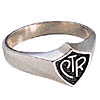
The CTR ring = choose the right. A reminder that righteousness is the way of God and Christ; the covenants we make with them and the care with which we treat ourselves and others.
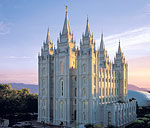 The Salt Lake temple = symbol of eternal life for ourselves with our families. In our temples we pledge our love and service, stand proxy for our deceased that they may be cleansed of their sins and enter into eternal covenants with Heavenly Father.
The Salt Lake temple = symbol of eternal life for ourselves with our families. In our temples we pledge our love and service, stand proxy for our deceased that they may be cleansed of their sins and enter into eternal covenants with Heavenly Father.
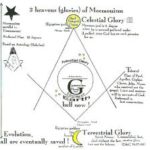
The Three Degrees of Glory = Symbol of the perfect Plan of Salvation. Represents the eternal rewards for actions taken during our earthly lives. The saved will be assigned to different degrees of glory commensurate with the law they have obeyed. The kingdoms, from lowest: telestial, terrestrial, celestial. These differ from one another in brilliance as do the sun, moon and stars.
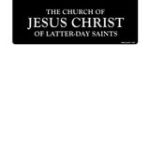 The missionary’s badge = Symbol of the men and women who serve throughout the world as representatives and emissaries of the LDS church, at their own expense, to gather, baptize, teach, heal and proclaim the Gospel of Jesus Christ.
The missionary’s badge = Symbol of the men and women who serve throughout the world as representatives and emissaries of the LDS church, at their own expense, to gather, baptize, teach, heal and proclaim the Gospel of Jesus Christ.
JEWISH
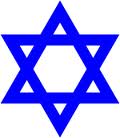
The Star of David = Symbol of Israel and the Jewish nation. Adorns the flag of Israel. Known as the shield of David, it is a symbol also of Jewish identity and Judaism in its completeness. The hexagram has been in use since a symbol of Jewishness since the 17th century, and was connected with the Seal of Solomon on Jewish flags. Considered by some an amulet (protection). In the Holocaust it was used as a method of identifying Jews. The star is also found on the Assembly Hall in Salt Lake City, near the temple there. This represents the bond that Mormons have with the Jewish people.
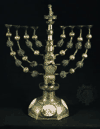
The Menorah and Hanukkah Lamp = The menorah is a religious symbol in Judaism. The original 7 branch menorah was placed in the Temple and its flames burned day and night. In modern synagogues, a single flame (usually electric) represents this ancient custom.
It symbolizes God’s eternal presence among the people. Many people inaccurately refer to the Chanukkiyah as a menorah. A Chanukkiyah is a nine branched candle holder used on the 8 days of Hanukkah.

The Shofar = the ram’s horn used for religious purposes. Shofar-blowing used in synagogue services on High Holy Days. In post-Biblical times, the shofar was enhanced in its religious use because of the ban on playing musical instruments as a sign of mourning for the destruction of the temple. (It is noted that a full orchestra played in the temple.) The shofar continues to announce the New Year,] to carry out the commandment to sound it on Rosh Hashanah, and to mark the end of the day of fasting on Yom Kippur once the services have completed in the evening.

The Pesach plate =Passover is a holiday full of ritual symbols that retell the Exodus story. Many of these symbols are displayed on the seder plate, which is the centerpiece of the seder table. A seder is a service held at home that concludes with a dinner. It is always observed on the first night of Passover, and in some homes on the second night as well. The items placed upon the Seder plate: vegetable (lettuce, parsley), shank bone (the Paschal –God- lamb), a roasted beet, a hard boiled egg (fertility or loss of temple), a mixture of apples, nuts, wine and spices (mortar to build bricks in Egypt), and bitter herbs (bitterness of slavery).
Those interested in learning about the many Jewish symbols of religious observance can read:
The Encyclopedia of Jewish Symbols (Frankel and Teutsch)
Menorahs, Mezuzas, and Other Jewish Symbols (Chaikin and Weihs)
Days of Awe: Jewish Holy days, symbols and prophecies for Latter-Day Saints (by Jewish convert-Gayle Boyd)
